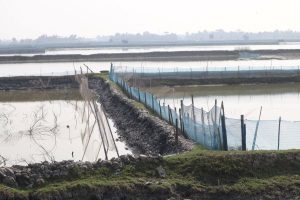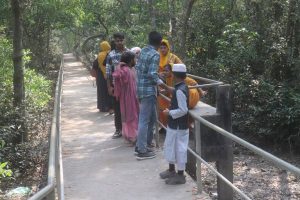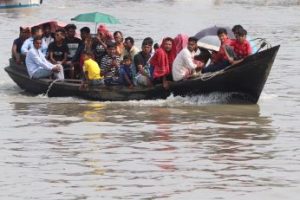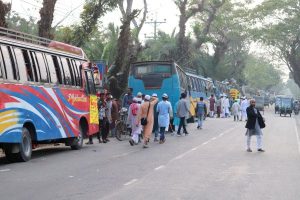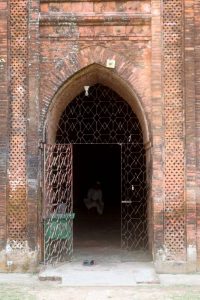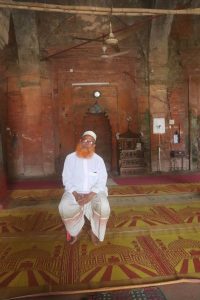Some you win, and some you lose. Our stay in Khulna was going to cover no less than two Unesco World Heritage sites: the Sundarbans and the so-called 60-dome mosque.
On the way, we pass through prawn culture country, with large ponds used to grow prawns. The fishermen’s houses, together with small huts on stilts, over the water, are located at the edges of the ponds, which are separated by coloured fishing nets. Right next to one of those pond complexes we encounter a rubbish dump, the effects of which no doubt seep through into the water.
The mangroves
The Sundarbans are the world’s largest mangrove forest, covering large parts of the delta formed by the confluence of the Ganges, Brahmaputra and Meghana rivers. It stretches over parts of India and Bangladesh, bordering the Bay of Bengal. A truly impressive, large nature area, of which most if not all is a national park, or at least protected wildlife area. With lots of wildlife, and a day to spare, you should be able to create an unforgettable tourist experience, one should think.
At the port of Mongla we embarked on a small, but exceedingly comfortable boat – soft sofas and sun roof -, for a 40 minutes plop-plop on the Rupsa river, to the Karamjal park. Where we got off, got a ticket, walked past a kind of a zoo, with crocodile cages, a deer enclosure and a single bird, and then took off for our jungle walk. On a concrete, raised causeway, together with hundreds of other tourists, and heaps of rubbish, empty bottles, crisps packages and more, next to the causeway. Fat chance seeing any wildlife this way, or birds. Which we indeed didn’t – except for the few monkeys who will opportunistically seek out the visitors. Halfway is an observation tower, for observing the canopy, and today also used for observing the foreigners: we were as much game to watch as any of the animals in the park, and far easier to spot and to photograph. After less than an hour we were back at the boat, and back on the river. Not exactly what I had expected from the Sundarbans.

as everybody sneakily takes photos of me, I don’t feel guilty doing the same to others; she noticed, and didn’t mind
But being on the river was actually the more entertaining part of the trip, navigating past the many ships waiting to be loaded, the sand dredgers mining sand from the bottom of the river, and the other boats criss-crossing the river. At the insistence of some of our group, we also stopped at a prostitute village – not to avail of the services on offer, to be sure, but to walk around and take pictures. Which was not really appreciated by the local women, of course.
The mosque
The second World Heritage site is the Shait Gumbat mosque, better known as the 60-dome mosque, in Bagarhat, a large brick-built mosque from the 15th Century, which in fact has 77 domes. The structure is pretty basic, a rectangular building with four conical turrets at the corners. Inside, the vaults are what characterises the building, as the mirhabs, all ten of them, are fairly basic in their decorations. But the real thing is the experience! This is obviously an important pilgrimage site for many Bangladeshis, and there is a continuous stream of local tourists flowing into the compound, with the occasional outcry at the entrance, when guards decide to temporarily close the access because there are too many people inside. Unfortunately, quite a few of those local tourists are subsequently distracted by the presence of foreigners, and the opportunity for selfies with them. The selfie obsession does become a little dense, at times.

and some of the men, generally happy to see visitors – although one man thought I shouldn’t be here, as I was not a Muslim
Nearby is another, smaller – 9-domed – mosque, which is architecturally perhaps even nicer than its big brother, and is without anybody else save the imam. Who takes me to a hole in one of the pillars, to touch with my finger. No idea why, but I assume it is for the better.
The mausoleum of Khan-I-Jahan, the ruler who had the big mosque built, is more popular, and does attract a fair amount of people. Women to the outer courtyard only, men are also allowed inside the mausoleum.
But nothing beats the stampede at the 60-dome mosque.
The market
In the evening I take a stroll, outside the hotel, to the local market. I got attracted to the fish sellers on the side of the streets, but then it turns out that there is a far bigger market inside, with more fish, chicken and turkey, and with fruit and vegetable. The sellers are, once again, only men. But they are so friendly again, proud to have their products photographed, and themselves. Great atmosphere. Great pictures. But why is this fish not penetrating to our dinner table in the various hotels and restaurants where we have been?
then, to Cox’s Bazar



